Necessities always lead to our attention, which inspires us with ideas, helping us come up with innovations and advancements making us proactive. From epidemics and pandemics in the past to the one we are going through, innovations have always helped us build strong defence mechanisms against them. It’s in our nature to sort out problems around us which may be miniscule or a global issue and find solutions or means to deal with them. Among the major challenges the world is facing currently, Climate change is by far the biggest one that has our hands full. Technology leaders, innovators and scientists are working tirelessly to help us build a sustainable future. Innovative products, resources and materials are already making us believe that technological evolution will certainly transform our lifestyle and help us adapt to such transformations boosting sustainability as a whole. Day in and day out we are witnessing novel ideas and inventions that elevate our optimism towards an imperishable world and to gather the most outshining of them, here are a few of these innovations in brief.
- Solar glass: Among the most remarkable inventions of this century, solar glass or photovoltaic glass is truly looking to be a game changer when it comes to harnessing renewable energy and having surplus utilities across all constructional domains. A solar glass is the same as a normal solar panel with the fundamental application to absorb sunlight but what makes it special is that it is transparent. Although it may seem logically impossible for a transparent material to absorb sunlight, scientists have sophisticatedly designed solar glass by sandwiching a unique resin and solar cells within two sheets of glass. The cell is capable of absorbing a specific spectrum of light which does limit its capacity but considering its other applications where regular glass in households, factories and other commercial spaces can be replaced by it, the potential of energy that can be harnessed by this technology has a huge scope.
- Carbon Capture & Storage (CCS): It is a combination of various technologies involved in entrapping industrial CO2 emissions followed by transportation and injecting them into underground reservoirs. The technicalities of this process are critical as it requires a specialised infrastructure right from the step of capturing CO2 as it involves its segregation from other emissions. It's not a simple filtration process and a lot of RnD is being involved to make the process more and more effective. Post the gases are captured, it is followed by transportation via customised steel pipes or automobiles since the gas has to be maintained at specific temperature and pressures. Subsequently, the storage units for these emissions need to have certain technical specifications like being at least 800m underground along with being a leak proof facility and having all safety measures in place. The technology is novel yet very promising to limit industrial Carbon Dioxide emissions to 85% if utilised efficiently.
- Self healing & Shape memory materials: Material science has been a top among major science fields contributing to build a sustainable world. The recent innovations in this field have seen the development of some interesting sustainable materials like the self healing polymers that are able to heal automatically after suffering any form of physical damage. Though in their nascent stage, these materials are already finding their applications in civil and mechanical engineering, automobile manufacturing, aerospace etc. On the other hand, Shape Memory Materials (SMMs) have the capability to restructure themselves to their original shape upon any plastic deformation enabling them in being utilised in medical technology, automobile and other major industries as the materials are resistant to the regular wear and tear, shearing and other structural damages. With these types of materials, there will be a huge reduction in wastage, a massive drop in material ageing and thus long lasting structures, devices and other industrial equipment.
- Energy Pavements: Based on the fundamental principle of piezoelectricity, wherein certain materials are able to generate electric pulses upon applying any form of mechanical pressure, comes the concept of energy pavements with an idea to generate electrical energy from the footsteps of general public that walks over them in areas which witness a huge footfall. Such a pavement already exists in a city in London harnessing this power. It's fascinating to just imagine the limitless potential of this technology. Malls, City centres, huge markets and other commercially busy places can all be lined up with piezoelectric tiles or floors enabling these places to be completely self sustainable in terms of energy requirements. The future of this technology can witness development of roads and crowded highways which will generate energy from the vehicular movement. Wind, rain and other forms of natural processes like geothermal energy may also impact these pavements generating electricity through the piezoelectric effect.
- Liquid wood & other Biodegradable plastics: Plastics have been by far the most challenging waste we produce due to its non biodegradable nature. Day on day, we are producing more plastic waste with a negligible recycling capacity which inturn impacts our waste management. As per recent statistics, there is nearly 8.3 billion tons of plastic which portrays the picture of what we are dealing with. Attempts to develop alternatives to this material have given us various forms of biodegradable plastics and most notably the liquid wood. Biodegradable plastics are also long chain polymers but can be disposed and degraded in a shooter span as compared to regular plastics mostly by the action of microbes. Liquid wood belongs to this category of plastics which is a complex combination of natural resins, flax and fibres which can be moulded into intricate shapes and structures with decent durability similar to plastics and with an advantage of being biodegradable. Also, liquid wood is completely weatherproof along with being UV resistant.
- Solar Balloons: Co-developed by Karen Assaraf, Julie Dautel, and Cédric Tomissi, solar balloons are primarily focused on being an energy source in crisis situations. The balloons are helium filled, fitted with solar panels and once deployed in the air are held afirm using nylon cabled. Employing the solar panels, the balloon generates electricity which can be utilised in critical situations. The balloon is self sufficient and is capable of generating as much as 3kWh of energy and remains functional 24x7. The balloon is also able to set up a telecommunications network being deployed at an altitude of upto 150m in less than an hour. Besides finding its applications in critical conditions like wildfires, storms, earthquakes etc, it can be also used for scientific missions which may include monitoring air quality and measuring other requisite data for accurately predicting weather conditions along with being a regular source of energy for the ground.
Globally, the frequency of such innovations & technological marvels unfolding is growing at a fast pace and are collectively assisting us to realise a sustainable future. Thought leaders, Industry experts, sustainability companies and like minded people collaborating and coming on the same page can further our chances to deal with catastrophic challenges like climate change hindering sustainability. Internationally big platforms like the upcoming London Climate Technology Show are in line with bringing together such institutions and stakeholders under the same roof with the aim to boost innovations, lead investments and acquire sustainability throughout.


